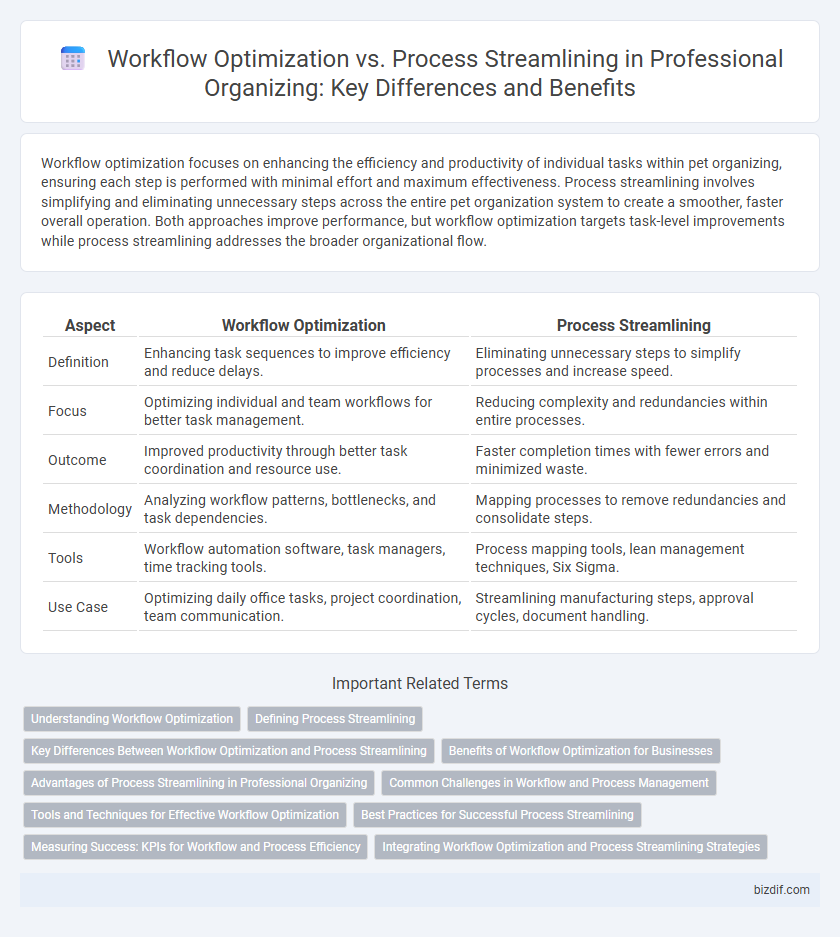Workflow optimization focuses on enhancing the efficiency and productivity of individual tasks within pet organizing, ensuring each step is performed with minimal effort and maximum effectiveness. Process streamlining involves simplifying and eliminating unnecessary steps across the entire pet organization system to create a smoother, faster overall operation. Both approaches improve performance, but workflow optimization targets task-level improvements while process streamlining addresses the broader organizational flow.
Table of Comparison
| Aspect | Workflow Optimization | Process Streamlining |
|---|---|---|
| Definition | Enhancing task sequences to improve efficiency and reduce delays. | Eliminating unnecessary steps to simplify processes and increase speed. |
| Focus | Optimizing individual and team workflows for better task management. | Reducing complexity and redundancies within entire processes. |
| Outcome | Improved productivity through better task coordination and resource use. | Faster completion times with fewer errors and minimized waste. |
| Methodology | Analyzing workflow patterns, bottlenecks, and task dependencies. | Mapping processes to remove redundancies and consolidate steps. |
| Tools | Workflow automation software, task managers, time tracking tools. | Process mapping tools, lean management techniques, Six Sigma. |
| Use Case | Optimizing daily office tasks, project coordination, team communication. | Streamlining manufacturing steps, approval cycles, document handling. |
Understanding Workflow Optimization
Understanding workflow optimization involves analyzing task sequences to improve efficiency, reduce bottlenecks, and enhance productivity. It focuses on aligning resources, tools, and team roles to ensure smooth operations within projects or daily tasks. Effective workflow optimization leads to measurable time savings and better quality outcomes compared to general process streamlining.
Defining Process Streamlining
Process streamlining involves simplifying and refining workflows by eliminating redundant steps and bottlenecks to enhance efficiency and reduce operational costs. It focuses on restructuring existing processes to create a more direct and seamless flow of tasks, improving overall productivity. Professional organizers apply process streamlining techniques to transform complex systems into clear, manageable sequences that support sustainable organization and time management.
Key Differences Between Workflow Optimization and Process Streamlining
Workflow optimization focuses on enhancing individual tasks and activities within a system to increase efficiency and reduce bottlenecks, utilizing techniques like task automation and time management. Process streamlining targets the overall sequence of processes, eliminating redundant steps and simplifying procedures to achieve smoother and faster results. The key difference lies in workflow optimization improving task-level performance, while process streamlining reconstructs the entire process flow for better productivity.
Benefits of Workflow Optimization for Businesses
Workflow optimization enhances business efficiency by identifying and removing bottlenecks, resulting in faster task completion and reduced operational costs. Streamlined workflows improve resource allocation and employee productivity, fostering a more agile and responsive organization. These improvements lead to higher customer satisfaction and increased profitability through consistent and reliable service delivery.
Advantages of Process Streamlining in Professional Organizing
Process streamlining in professional organizing reduces redundant tasks, enabling more efficient use of time and resources. It enhances consistency and accuracy by establishing standardized procedures, resulting in higher-quality outcomes for clients. Streamlined processes improve scalability and adaptability, allowing organizers to handle increased workloads without compromising service quality.
Common Challenges in Workflow and Process Management
Common challenges in workflow optimization and process streamlining include unclear task definitions, redundant steps, and lack of automation tools that hinder efficiency. Miscommunication between teams often results in bottlenecks and delays, impacting overall productivity. Effective workflow management requires identifying these issues early and implementing standardized procedures to reduce ambiguity and eliminate unnecessary work.
Tools and Techniques for Effective Workflow Optimization
Workflow optimization leverages advanced tools such as project management software, time-tracking apps, and automation platforms to enhance task prioritization and resource allocation. Techniques like value stream mapping and Kanban boards provide visual insights into process inefficiencies, enabling targeted improvements. Effective workflow optimization integrates these digital solutions to reduce bottlenecks and accelerate project completion, outperforming traditional process streamlining methods.
Best Practices for Successful Process Streamlining
Best practices for successful process streamlining in professional organizing emphasize identifying bottlenecks and eliminating redundant tasks to enhance workflow efficiency. Utilizing tools like flowcharts and automation software ensures consistent and measurable improvements. Continuous evaluation and employee feedback drive sustained optimization and adaptability in workflows.
Measuring Success: KPIs for Workflow and Process Efficiency
Measuring success in workflow optimization and process streamlining relies heavily on KPIs such as cycle time, throughput, and error rates to evaluate efficiency gains. Tracking employee productivity and task completion rates provides insights into workflow enhancements, while process streamlining benefits from monitoring cost savings and resource utilization. These quantifiable indicators enable organizations to identify bottlenecks and continuously improve operational performance.
Integrating Workflow Optimization and Process Streamlining Strategies
Integrating workflow optimization and process streamlining strategies enhances efficiency by eliminating redundancies and improving task sequencing within professional organizing systems. Leveraging tools like Kanban boards and automation software enables real-time monitoring and adjustment, reducing bottlenecks and accelerating project completion. Combining these approaches fosters a cohesive operational framework that maximizes productivity and resource allocation.
workflow optimization vs process streamlining Infographic

 bizdif.com
bizdif.com